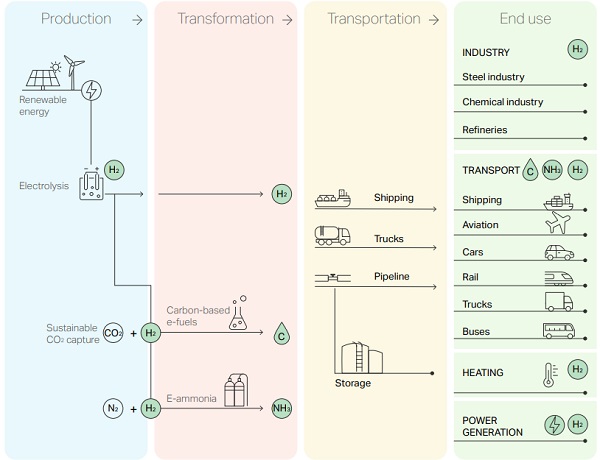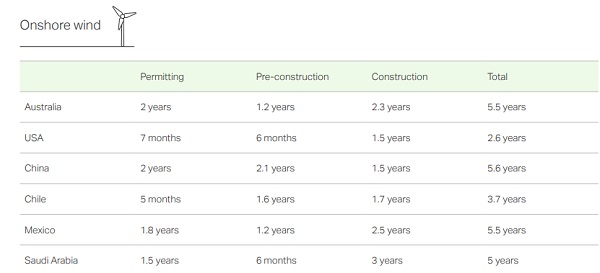Maersk: Electricity availability limits e-fuels in the maritime industry
Maersk Mc-Kinney Moller Center presented its Renewable Energy Positioning paper yesterday, in which identified four key constraints that may hinder the supply of renewable electricity to the maritime industry in the 2030s and 2040s, potentially leading to a shortage of e-fuels.
In particular, decarbonizing the maritime industry will depend on alternative fuels. E-fuels are attractive because they offer the possibility to achieve substantial emission reductions. However, decarbonizing the maritime industry with low-emissions e-fuels will require a sufficient supply of renewable electricity, which is also increasingly in demand from other sectors that are also trying to decarbonize.
According to Maersk, there are four key constraints which may limit renewable electricity supply to the maritime industry in the 2030s and 2040s, and may result in a shortage of e-fuels:
- The most concerning constraint is the availability of copper, a key material for solar and wind installations, which is typically slow to increase supply.
- Nickel is also a concern, as it is already in high demand. Nickel is used in electrolyzers, which will be vital for producing hydrogen from renewable electricity for load balancing and e-fuels.
- A shortage of rare earths may limit wind installations, but this may be overcome by using geared rotors that do not rely on rare earths.
- Labor may be a constraint across the supply chain, from installing and maintaining solar and wind capacity, to increasing the manufacturing of transmission components. Workers could be transferred from oil and gas to combat this constraint. However, this will require retraining, which takes time.
If there is insufficient renewable electricity to meet demand from all industries, cross-sector competition and prices will increase. As the maritime sector has some of the highest abatement costs, it may not be willing or able to compete for high-cost renewable electricity, limiting e-fuel availability and hampering decarbonization efforts.
| Read More: Maersk Mc-Kinney Moller Center unveils ammonia-fueled boxship design |
In this report, Maersk analyzed the political climate and regulatory factors in six countries with high technical potential for wind and solar installations and renewable electricity costs in the lowest 20% globally. National policies vary, and the situation is unique in each country. However, they found that most countries were increasingly in favor of renewables.
As explained, in the future, the global apply of renewable electricity will be limited to the global technical potential to produce renewable electricity, i.e., the energy content of all wind and solar resources that can be effectively harvested through the installation of wind parks and photovoltaics. Key factors in the global technical potential include: the energy content of worldwide wind and solar radiation, the efficiency of converting this primary energy into electricity, and the availability of suitable land to harvest energy from wind and solar.

Will regulation and political barriers limit scale-up?
Ramping up renewable electricity supplies will demand political willingness and regulatory support. Maersk analyzed the regulatory frameworks and challenges in six countries with high technical potentials for wind and solar installations and renewable electricity costs in the lowest 20% globally: Australia, the United States of America (USA), China, Chile, Mexico, and Saudi Arabia. Any of these countries alone could supply the renewable electricity needed for e-fuels by the maritime industry.
However, political or regulatory factors will be major barriers to renewable electricity scaleup. Although the situation in each country is unique, governments are increasingly becoming more in favor of renewables. Furthermore, permitting times are generally adequate. However, e-fuel producers should carefully analyze their chosen country’s political and regulatory situation before embarking on renewable electricity projects.

Copper supply may limit capacity in the 2030s
Copper is used extensively in technologies that are key to the energy transition, including energy generation, electric vehicles, electrolyzers, networks, and heat pumps. It is also a key material in wind and solar installations. Currently, 20 million tonnes of copper are produced annually,21 with around 5 million harvested from recycled copper. Clean energy technologies already use over 20% of the world’s annual copper production, and demand is set to increase with electrification and decarbonization.
Recommendations
Although the long-term potential for renewable electricity is obviously sufficient, the analysis suggests that constraints in scaling up will limit wind and solar availability for producing e-fuels in the 2030s and possibly into the 2040s. The main likely constraints include the limited availability of key materials such as copper and nickel for electrolyzers.
Furthermore, labor shortages may also limit scale-up. Although the maritime industry is unlikely to rely on transmission components or offshore wind to the extent that the power generation sector will, limitations on transmission component manufacturing and installation vessels or offshore wind may also increase the pressure on global renewable electricity supplies and thereby increase prices.
Source: Safety4sea
| Read Here | |
 |
|








































